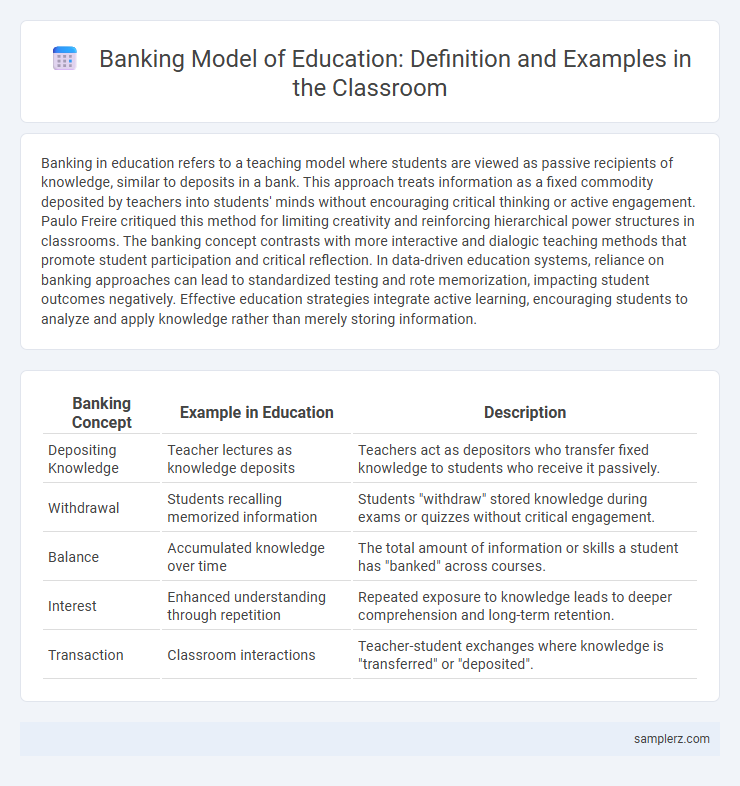Banking in education refers to a teaching model where students are viewed as passive recipients of knowledge, similar to deposits in a bank. This approach treats information as a fixed commodity deposited by teachers into students' minds without encouraging critical thinking or active engagement. Paulo Freire critiqued this method for limiting creativity and reinforcing hierarchical power structures in classrooms. The banking concept contrasts with more interactive and dialogic teaching methods that promote student participation and critical reflection. In data-driven education systems, reliance on banking approaches can lead to standardized testing and rote memorization, impacting student outcomes negatively. Effective education strategies integrate active learning, encouraging students to analyze and apply knowledge rather than merely storing information.
Table of Comparison
| Banking Concept | Example in Education | Description |
|---|---|---|
| Depositing Knowledge | Teacher lectures as knowledge deposits | Teachers act as depositors who transfer fixed knowledge to students who receive it passively. |
| Withdrawal | Students recalling memorized information | Students "withdraw" stored knowledge during exams or quizzes without critical engagement. |
| Balance | Accumulated knowledge over time | The total amount of information or skills a student has "banked" across courses. |
| Interest | Enhanced understanding through repetition | Repeated exposure to knowledge leads to deeper comprehension and long-term retention. |
| Transaction | Classroom interactions | Teacher-student exchanges where knowledge is "transferred" or "deposited". |
Understanding the Banking Model in Education
The banking model in education treats students as passive recipients of knowledge, where teachers deposit information into their minds without encouraging critical thinking or active participation. This approach often stifles creativity and limits deep understanding, as students are expected to memorize facts rather than engage with concepts. Paulo Freire critically analyzed this model, advocating for a more dialogic and problem-posing method that promotes awareness and transformative learning.
Key Characteristics of Banking Education
Banking education treats students as passive repositories where knowledge is deposited by the teacher, emphasizing rote memorization over critical thinking. This method prioritizes the transmission of fixed information, suppressing creativity and questioning. Students in banking education often lack opportunities for dialogue, resulting in limited engagement and critical reflection.
Classroom Examples of Banking Practices
In education, banking practices manifest as students passively receiving information without critical engagement, such as memorizing facts for exams without understanding concepts. Classroom examples include teachers delivering lectures where students only take notes and later reproduce content during assessments, illustrating knowledge as a deposit rather than active construction. This approach limits creativity and critical thinking, as learning is viewed as a one-way process of banking information rather than interactive knowledge-building.
Teacher-Centered Approaches in Banking Education
Teacher-centered approaches in banking education treat students as passive recipients of knowledge, where educators deposit information directly into their minds. This model emphasizes memorization and repetition, limiting critical thinking and active engagement in the learning process. Paulo Freire's critique highlights that banking education reinforces hierarchical relationships, hindering students' creativity and transformative learning.
Student Passivity in Traditional Classrooms
Student passivity in traditional classrooms resembles banking education, where teachers deposit information while students receive it passively, limiting critical thinking and engagement. This model treats learners as empty vessels rather than active participants in constructing knowledge, which stifles creativity and deeper understanding. Research shows that shifting towards interactive and participatory teaching methods enhances student motivation and academic performance significantly.
Memorization Over Critical Thinking: A Banking Example
The banking model of education views students as passive recipients of knowledge, emphasizing memorization rather than critical thinking. This approach mirrors a bank transaction where information is "deposited" into students' minds without encouraging active analysis or questioning. Such a methodology limits creativity and problem-solving skills, hindering deeper understanding and intellectual growth.
The Role of Authority and Control in Banking Education
Banking education, as coined by Paulo Freire, positions students as passive recipients of knowledge controlled by the authority of teachers, reinforcing hierarchical power dynamics. This model emphasizes rote memorization and rigid control, limiting critical thinking and creativity in the learning process. Such an approach sustains systemic inequalities by discouraging dialogue and active participation in education.
Assessment Styles in the Banking Model
The banking model of education emphasizes rote memorization and standardized testing as key assessment styles, where students are viewed as passive recipients of information rather than active participants. This method often relies on multiple-choice exams and regurgitation of facts, limiting critical thinking and creativity. Such assessments reinforce a one-size-fits-all approach, neglecting diverse learning styles and deeper understanding.
Case Study: Banking Model in Modern Schools
The Banking Model in modern schools exemplifies a traditional education approach where teachers deposit information into passive students, treating knowledge as a commodity. This method limits critical thinking and creativity, focusing on rote memorization rather than active learning. Case studies reveal that shifting from this model to more interactive pedagogies enhances student engagement and improves educational outcomes.
Moving Beyond Banking: Alternatives in Education
Moving beyond banking in education involves shifting from rote memorization to critical thinking and problem-solving approaches that foster deeper understanding. Techniques such as project-based learning, inquiry-based instruction, and collaborative problem solving serve as effective alternatives by promoting active student engagement and real-world application of knowledge. These methods enhance cognitive development and prepare learners for complex challenges beyond the classroom environment.

example of banking in education Infographic
 samplerz.com
samplerz.com